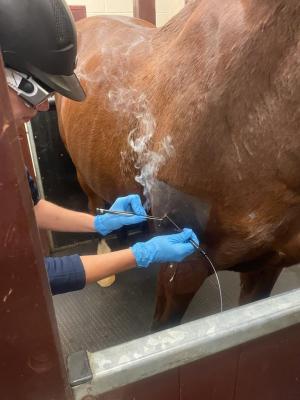Equine Therapy Success Stories: Real Individuals, Actual Psychological Improvements
Wiki Article
Exactly How Laser Treatment in Equine Therapy Is Transforming Vet Care for Equines
Laser therapy has arised as a transformative technique in equine vet treatment, offering a non-invasive option that quickens recovery and improves general health and wellness. The mobility and adaptability of laser treatment gadgets even more highlight their growing indispensability among vets.
Recognizing Laser Treatment
Comprehending laser therapy is important for valuing its duty in equine treatment. Laser therapy, additionally called photobiomodulation, includes the application of particular wavelengths of light to tissues, which can cause different biological results. This healing technique harnesses the power of light energy to permeate the skin and underlying tissues, boosting mobile processes and boosting tissue fixing.The modern technology behind laser therapy is based in the concept of photochemistry, where photons are absorbed by chromophores within cells, bring about boosted ATP production and inflection of reactive oxygen varieties. This, consequently, advertises cellular spreading, minimizes inflammation, and speeds up healing. Veterinary practitioners use different kinds of lasers, including low-level lasers (LLLT) and high-power Class IV lasers, relying on the certain therapeutic goals and the nature of the equine problem being treated.
Various laser wavelengths and power settings are very carefully selected to target different cells depths and accomplish wanted medical end results. Safety methods are critical, as inappropriate use can lead to thermal damages or suboptimal healing impacts. Hence, a comprehensive understanding of laser treatment's devices and applications is important for its reliable implementation in equine vet technique.
Benefits for Equine Health And Wellness
The myriad benefits of laser therapy for equine health and wellness incorporate enhanced recovery, pain reduction, and boosted mobility. This sophisticated therapy method leverages specific wavelengths of light to permeate cells, promoting mobile feature and advertising quick cells repair. The non-invasive nature of laser therapy makes sure marginal stress and anxiety and pain for the horse, assisting in a smoother recuperation procedure.
Better wheelchair is one more crucial advantage, specifically for performance and functioning equines. By reducing swelling and pain, and boosting cells repair, laser treatment helps in recovering joint function and muscle adaptability. The advancing effect of these benefits is not only a quicker go back to normal task but additionally a general enhancement in the steed's high quality of life. Thus, laser treatment stands as a transformative device in contemporary equine vet care.
Common Problems Treated
Laser treatment has become a flexible treatment choice for a selection of common equine problems. Among these, musculoskeletal injuries are especially responsive to laser therapy. Soft tissue injuries, such as tendonitis and tendon pressures, gain from the anti-inflammatory and analgesic impacts of laser therapies, which increase healing and decrease pain. In addition, laser treatment works for conditions like osteo arthritis, where it aids mitigate joint inflammation and promote tissue repair service.Wound monitoring is another area where laser therapy has revealed considerable pledge. Persistent injuries or slow-healing abscess can be especially difficult in equines, however laser treatment improves cellular regeneration and improves blood circulation, thus speeding up the healing process. Laser treatments have actually been efficiently utilized in handling hoof conditions such as laminitis and abscesses, alleviating discomfort and promoting much faster recuperation.
useful link Horse athletes frequently deal with performance-related concerns like muscular tissue discomfort and anxiety fractures. Laser treatment help in decreasing muscle exhaustion and quickens the healing of micro-injuries, thus ensuring that steeds return to peak efficiency much more quickly. By resolving these varied conditions, laser therapy is changing the landscape of veterinary treatment, supplying a non-invasive, efficient alternative to traditional treatments.
Technology Behind Laser Treatment

Laser devices utilized in vet medication frequently make use of low-level laser treatment (LLLT) or cold laser therapy. Unlike high-powered medical lasers, these tools run at lower energy levels, maximizing healing benefits while reducing thermal damages. The power from the laser light boosts adenosine triphosphate (ATP) production, enhances mobile metabolic process, and accelerates cells repair service procedures.
Modern laser treatment devices for equine treatment is designed with adjustable setups to provide to the certain requirements of different cells and problems. Furthermore, developments in laser technology have led to the growth of mobile, handheld devices, making it less complicated for vets to supply treatment in a variety of setups, from centers to stables.
Success Stories and Study
Showcasing the substantial advantages of laser therapy, numerous success tales and situation research studies illuminate its transformative influence on equine wellness. One such situation involves a pureblood racehorse suffering from persistent tendonitis. Standard treatments you can try these out yielded marginal enhancement, but after incorporating laser therapy right into the regimen, the steed showed significant decreases in inflammation and discomfort within weeks, ultimately going back to competitive auto racing.Another compelling instance includes a dressage steed diagnosed with serious back discomfort, limiting its performance. A veterinary group used low-level laser therapy (LLLT) to target the inflamed areas, causing significant improvement in flexibility and a significant decline in pain. Over several sessions, the equine restored its peak kind, showcasing the efficiency of laser treatment in description addressing musculoskeletal problems.
Furthermore, a research carried out at a leading equine facility taken a look at 50 horses with numerous soft tissue injuries treated with laser treatment. The results stood out: 85% of the equines demonstrated sped up healing times and enhanced wheelchair. These instances emphasize the versatility and effectiveness of laser therapy in equine medicine, offering a non-invasive, scientifically-backed approach to enhancing recuperation and efficiency in steeds.
Verdict
Laser treatment is changing equine vet treatment by offering a non-invasive treatment that accelerates healing, reduces swelling, and alleviates discomfort. With its performance in treating a range of problems, from bone and joint injuries to chronic ailments like osteo arthritis, this modern technology dramatically boosts equine health and wellness and movement. The portability and adaptability of laser treatment additionally underscore its transformative influence on vet methods, solidifying its duty as an essential device in contemporary equine healthcare.Report this wiki page